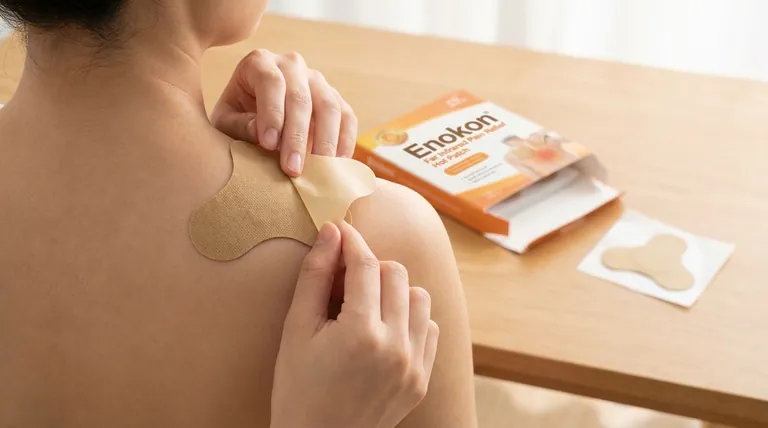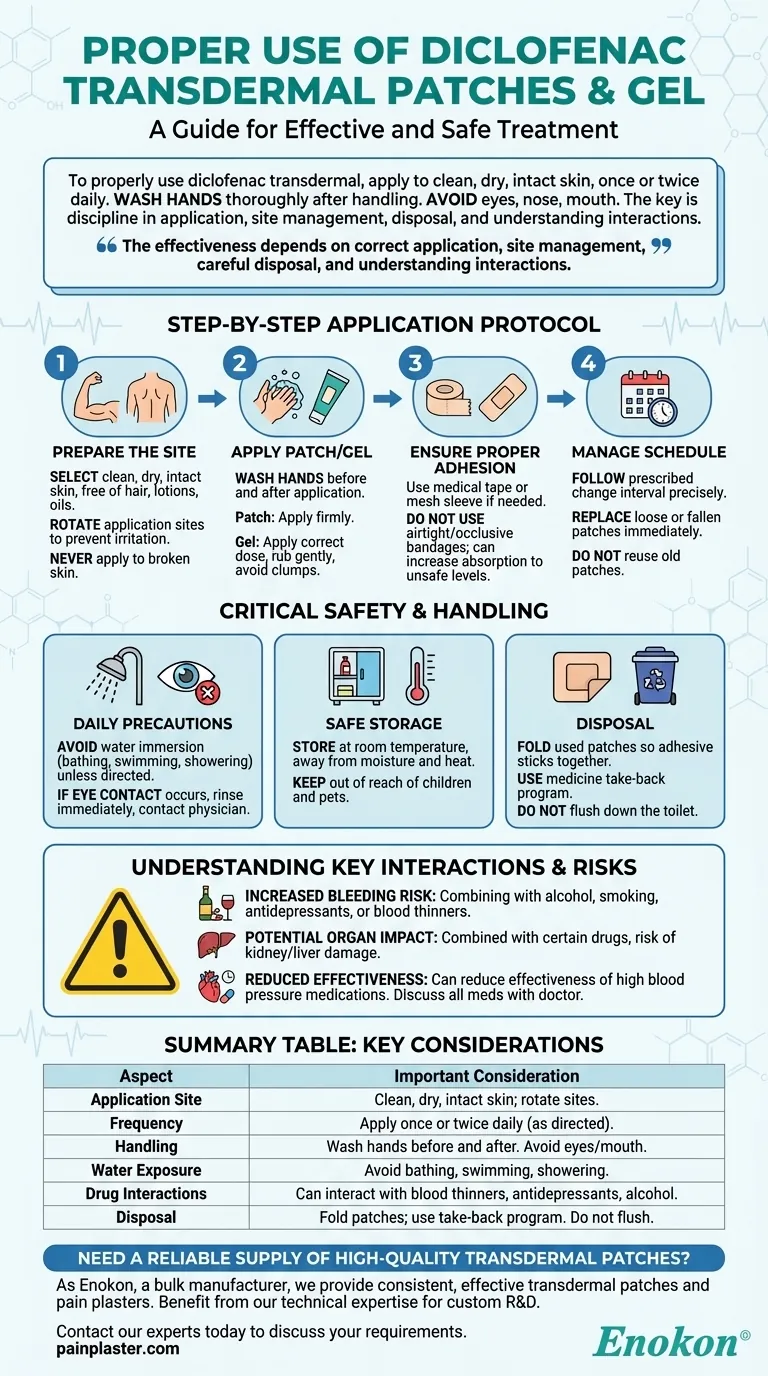To properly use diclofenac transdermal, you must apply it to clean, dry, and intact skin, typically once or twice daily as directed by your physician. It is critical to wash your hands thoroughly after handling the patch or gel and to avoid applying it near the eyes, nose, or mouth to prevent irritation and unintended absorption.
The effectiveness of transdermal diclofenac depends not just on correct application, but on a disciplined routine of site management, careful disposal, and a clear understanding of its potential interactions with other medications and daily activities.

The Step-by-Step Application Protocol
Proper application is the foundation of effective treatment. Following these steps ensures the medication is absorbed correctly and consistently.
Preparing the Application Site
First, select an appropriate area of skin. Ideal locations include the upper arm or back, but you should always follow your doctor's specific instructions.
The chosen skin must be clean, dry, and free of hair, lotions, or oils, as these substances can interfere with adhesion and absorption.
To prevent skin irritation, it is essential to rotate application sites with each new dose. Never apply the medication to broken or irritated skin.
Applying the Patch or Gel
Whether using a patch or gel, wash your hands before and after application to prevent spreading the medication to other areas or other people.
Apply the patch firmly to the skin. If using a gel, apply the correct dose and rub it in gently. Avoid leaving clumps of medication on the skin.
Ensuring Proper Adhesion
If a patch does not stick well, you may use medical tape or a supplied mesh sleeve to hold it in place.
Crucially, do not use airtight or occlusive bandages over the patch. This can trap excess heat and increase drug absorption to unsafe levels.
Managing Your Application Schedule
Follow the prescribed change interval precisely, whether it is daily or on another schedule.
If a patch becomes loose or falls off, replace it with a new one immediately. Do not attempt to reuse an old patch.
Critical Safety and Handling Procedures
Beyond application, how you handle, store, and dispose of the medication is vital for your safety and the safety of others.
Daily Activities and Precautions
You should avoid activities that immerse the application site in water, such as bathing, showering, or swimming, while wearing a patch unless otherwise directed.
If the medication accidentally comes into contact with your eyes, rinse them immediately with water and contact your physician if irritation persists.
Safe Storage and Disposal
Store the medication at room temperature in its original, tightly closed container, away from moisture and heat.
Always keep this and all medications out of the reach of children and pets.
For disposal, fold used patches so the adhesive sides stick together. The safest method is to use a medicine take-back program. Do not flush patches down the toilet.
Understanding Key Interactions and Risks
Diclofenac is a nonsteroidal anti-inflammatory drug (NSAID), and even in transdermal form, it can interact with other substances and carry risks.
The Risk of Increased Bleeding
Using diclofenac while consuming alcohol or smoking can increase your risk of stomach bleeding.
This risk is also elevated when combined with other medications, such as antidepressants or blood thinners.
Potential Organ Impact
Combining diclofenac with certain other medications can create a risk of kidney or liver damage. This includes some drugs used for infections, cholesterol, seizures, or cancer.
Always provide your doctor with a complete list of all medications you take, including over-the-counter drugs, vitamins, and herbal products.
Reduced Effectiveness of Other Drugs
Diclofenac can potentially reduce the effectiveness of medications prescribed for high blood pressure. Open communication with your doctor is key to managing this.
How to Apply This to Your Treatment
Your approach should be guided by your specific health profile and treatment goals.
- If your primary focus is maximizing pain relief: Adhere strictly to the application protocol and schedule to ensure consistent, predictable dosing.
- If your primary focus is avoiding side effects: Be vigilant about rotating application sites and immediately report any skin irritation or other adverse reactions to your doctor.
- If you are taking other medications: Proactively discuss your full medication list with your doctor and pharmacist to screen for potentially harmful drug interactions.
By treating your transdermal medication with meticulous care, you take active control of your treatment and ensure the safest, most effective outcome.
Summary Table:
| Key Aspect | Important Consideration |
|---|---|
| Application Site | Clean, dry, intact skin; rotate sites to prevent irritation. |
| Frequency | Apply once or twice daily, or as directed by your physician. |
| Handling | Wash hands before and after application. Avoid contact with eyes/mouth. |
| Water Exposure | Avoid bathing, swimming, or showering while wearing a patch. |
| Drug Interactions | Can interact with blood thinners, antidepressants, and alcohol. |
| Disposal | Fold used patches; use a medicine take-back program. Do not flush. |
Need a reliable supply of high-quality transdermal patches?
As Enokon, a bulk manufacturer of reliable transdermal patches and pain plasters, we provide healthcare and pharma distributors and brands with consistent, effective products. Benefit from our technical expertise for custom R&D and development to create a solution tailored to your patients' needs.
Contact our experts today to discuss your requirements and how we can support your business.
Visual Guide

Related Products
- Far Infrared Deep Heat Relief Patches Medicated Pain Relief Patches
- Far Infrared Heat Pain Relief Patches Transdermal Patches
- Heating Pain Relief Patches for Menstrual Cramps
- Asthma Cough and Pain Relief Patch for Adults and Kids
- Mugwort Wormwood Pain Relief Patch for Neck Pain
People Also Ask
- How should pain relief patches be applied and used? A Guide to Safe & Effective Targeted Relief
- How do Deep Heat Pain Relief Patches provide pain relief? Discover the Drug-Free Mechanism
- How effective are pain relief patches for muscle pain? Target Localized Pain with Transdermal Delivery
- How do pain relief patches provide targeted relief? Discover the Science Behind Effective Pain Management
- How do pain relief patches compare to other pain relief methods? Discover Targeted, Long-Lasting Relief
















